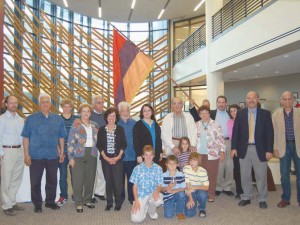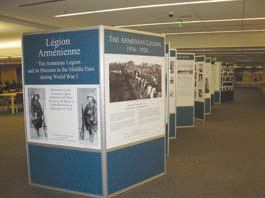Armen Meldonian
Staff Writer

The Armenian Studies Program at Fresno State and the Henry Madden Library hosted a special opening reception for a traveling exhibit called “Légion Arménienne: The Armenian Legion and Its Heroism in the Middle East” at 3:00 pm on Sunday, November 1. The exhibit was prepared by the Watertown, Massachusetts-based Armenian Library and Museum of America.
Prof. Barlow Der Mugrdechian of the Armenian Studies Program presented a brief history on the formation of the Armenian Legion, an all-volunteer military division compose mainly of Armenians and organized for “the sole purpose of liberating Cilicia from Turkish rule.” The Legion had its beginnings in 1916 and was eventually disbanded in 1920, existing during several years of momentous change for the Armenians: the Armenian Genocide, the rise of communism in Russia, the first Armenian Republic, and World War I.
There were several members in the audience whose family members fought in the Armenian Legion. The Shishmanian family had two relatives; Arminee Shishmanian’s father Smpat Shanazarian and her uncle Arshavir Shanazarian. Edward Hagopian’s father, drafted into the Turkish Army in 1913, left the Army in 1915 when the Turks began using the Armenian soldiers for forced labor and were preparing for them to be executed. He managed to get into the Armenian Legion soon after, and remained until 1919.
John Machoian spoke about two relatives who had been in the Legion; his grandfather Moses Machoian and great-uncle Stephen Krikorian, who were volunteers from the United States. John Machoian’s father, Edward, noted that many of the Legionnaires were in their twenties and wanted “to go back and try to help the people,… they believed that things should not have happened as they did.” Machoian discussed how his mother was 10 years old at the time of the forced marches across the desert and how his father had been injured by shrapnel during the war, but they didn’t talk to him much about the events when he was younger. Also included among the families present was Rosemary Vartanian, whose father Nishan Chalebian had fought in the Legion. Numerous pieces of memorabilia, including clothing, photos, and equipment from the Machoian family was also displayed.
The Armenian Legion was established when an agreement was formed between Armenian statesman and businessman Boghos Nubar Pasha and the governments of France and Great Britain on October 27, 1916, to volunteer Armenians to fight with the Allies against the Turkish front. The Armenian Legion was initially known as the “Eastern Legion” rather than “Armenian Legion” so as to not provoke the Ottoman Empire, which continued its campaign against Armenian civilians.
The agreement involved promised autonomy of Armenians in Cilicia, a part of southern Turkey that was the home of a medieval Armenian kingdom and a large Armenian population for centuries.
The Armenian National Union recruited Armenian volunteers from the United States in late 1916 to 1917, raising about 1,200 volunteers and approximately 4,000 total in later recruitments. The men were trained by French officers in Cyprus over an intensive, 10 month program. The soldiers were then sent to Port Said, Egypt to join the Allied forces and eventually included Syrian volunteers as well. Under the command of British General Edmund Allenby, the Armenian Legion’s first successful objective was the taking of Arara, Palestine in September 18, 1918. Arara was defended with heavy artillery fire by the Turkish Seventh Army, commanded by General Mustafa Kemal (who would be later known as Ataturk, founder of the modern Turkish nation) and under the control of German General Otto Liman von Sanders. The Armenians successfully took the hill of Arara on the first day of the attack, September 19, 1918.
 The Turkish army was then in retreat as General Allenby advanced north to Aleppo, Damascus, and Beirut. On October 7, 1918, the Eastern Legion was divided, separating the Syrian troops, and would then be known as the Armenian Legion. Turkey withdrew from the war on October 31, 1918.
The Turkish army was then in retreat as General Allenby advanced north to Aleppo, Damascus, and Beirut. On October 7, 1918, the Eastern Legion was divided, separating the Syrian troops, and would then be known as the Armenian Legion. Turkey withdrew from the war on October 31, 1918.
The Legionnaires passed through Palestine and Syria, coming across the remains of Armenians deported, massacred, and left to perish in the Syrian desert. They found some survivors. During the time of the Armenian Legion, the Allies in Syria found 200,000 deported Armenians who survived the Genocide and in 1919, 120,000 to 150,000 Armenian exiles were repatriated to their homes throughout Cilia, with 50,000 more shipped by rail to their homes in western Asia Minor.
In 1921, the French concluded negotiations with the Accord of October, where France would recognize Nationalist Turkey. The Armenian Legion was meanwhile disbanded, and many of the promises to the Armenians were absent from treaties over the Middle East over the aftermath of World War I. The Armenian Legion was disbanded with the agreements having failed to ultimately materialize, but memory of the Legion’s efforts continues to this day. The traveling exhibit on the Armenian Legion serves as one reminder.
The exhibit will run on the second floor of the Henry Madden Library until the end of November. The exhibit will continue move to venues in Los Angeles and Detroit.
 Hye Sharzhoom Armenian Action
Hye Sharzhoom Armenian Action